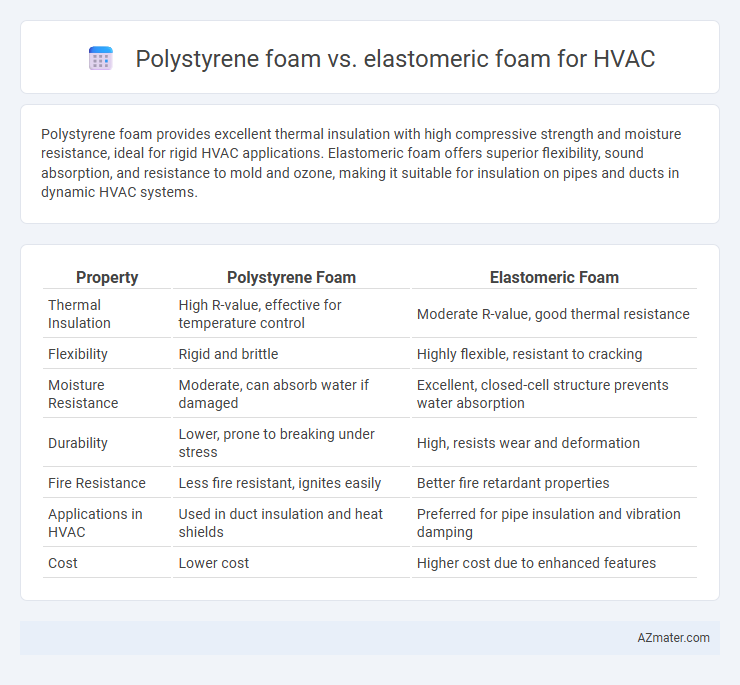Polystyrene foam provides excellent thermal insulation with high compressive strength and moisture resistance, ideal for rigid HVAC applications. Elastomeric foam offers superior flexibility, sound absorption, and resistance to mold and ozone, making it suitable for insulation on pipes and ducts in dynamic HVAC systems.
Table of Comparison
| Property | Polystyrene Foam | Elastomeric Foam |
|---|---|---|
| Thermal Insulation | High R-value, effective for temperature control | Moderate R-value, good thermal resistance |
| Flexibility | Rigid and brittle | Highly flexible, resistant to cracking |
| Moisture Resistance | Moderate, can absorb water if damaged | Excellent, closed-cell structure prevents water absorption |
| Durability | Lower, prone to breaking under stress | High, resists wear and deformation |
| Fire Resistance | Less fire resistant, ignites easily | Better fire retardant properties |
| Applications in HVAC | Used in duct insulation and heat shields | Preferred for pipe insulation and vibration damping |
| Cost | Lower cost | Higher cost due to enhanced features |
Introduction to HVAC Insulation Materials
Polystyrene foam and elastomeric foam are widely used HVAC insulation materials, each offering distinct thermal and physical properties critical for system efficiency. Polystyrene foam provides excellent rigidity and moisture resistance, making it ideal for applications requiring structural support and thermal insulation. Elastomeric foam excels in flexibility and vapor barrier capabilities, reducing condensation and energy loss in HVAC ductwork and piping systems.
Overview of Polystyrene Foam in HVAC
Polystyrene foam, commonly used in HVAC systems, offers excellent thermal insulation due to its closed-cell structure, which effectively reduces heat transfer and energy consumption. Its lightweight and moisture-resistant properties make it ideal for duct insulation and preventing condensation buildup in HVAC applications. The material's cost-effectiveness and ease of installation contribute to its widespread adoption in residential and commercial heating, ventilation, and air conditioning systems.
Overview of Elastomeric Foam in HVAC
Elastomeric foam in HVAC systems offers superior thermal insulation, moisture resistance, and flexibility, making it ideal for insulating pipes, ducts, and equipment. Its closed-cell structure prevents condensation and reduces energy loss, enhancing system efficiency and longevity. Compared to polystyrene foam, elastomeric foam provides better durability and ease of installation in varying temperature conditions.
Thermal Insulation Properties: Polystyrene vs Elastomeric
Polystyrene foam offers high thermal resistance with an R-value typically ranging from 4 to 5 per inch, making it effective for insulating ductwork and HVAC components by reducing heat transfer. Elastomeric foam provides excellent thermal insulation with an R-value around 4 per inch while also offering superior flexibility and moisture resistance, which helps prevent condensation and energy loss in HVAC systems. When comparing thermal insulation properties, polystyrene foam excels in rigid insulation applications, whereas elastomeric foam is favored for flexible, moisture-prone environments requiring consistent thermal performance.
Moisture Resistance Comparison
Polystyrene foam exhibits moderate moisture resistance, providing a water barrier that slows moisture absorption but may allow moisture infiltration over time, potentially leading to mold growth in HVAC systems. Elastomeric foam offers superior moisture resistance due to its closed-cell structure and non-porous surface, effectively preventing water vapor penetration and reducing condensation risks. HVAC applications benefit from elastomeric foam's enhanced durability and long-term protection against moisture damage compared to polystyrene foam.
Fire Safety Performance
Elastomeric foam offers superior fire safety performance in HVAC applications compared to polystyrene foam, as it is self-extinguishing and meets stringent fire resistance standards like UL 94. Polystyrene foam, while lightweight and insulating, is highly flammable and can release toxic smoke during combustion, posing greater risks in fire incidents. Choosing elastomeric foam enhances overall system safety by reducing flame spread and smoke development, essential for compliance with building codes and occupant protection.
Installation and Flexibility
Polystyrene foam offers a rigid structure that simplifies installation in straight sections of HVAC ductwork but lacks flexibility to accommodate bends or irregular surfaces. Elastomeric foam provides superior flexibility, making it ideal for wrapping complex shapes and reducing gaps during installation, which enhances overall thermal insulation efficiency. Its pliable nature also speeds up the installation process by conforming easily to ducts, pipes, and varying HVAC components without cracking or breaking.
Cost Analysis: Polystyrene vs Elastomeric
Polystyrene foam offers a lower initial cost compared to elastomeric foam, making it a budget-friendly choice for HVAC insulation. Elastomeric foam, while more expensive upfront, provides superior durability and thermal performance, potentially reducing long-term maintenance and energy expenses. Evaluating the total cost of ownership, including installation, lifespan, and energy savings, is essential when choosing between polystyrene and elastomeric foam for HVAC applications.
Environmental Impact and Sustainability
Polystyrene foam in HVAC applications is less environmentally sustainable due to its non-biodegradable nature and reliance on petroleum-based materials, contributing to significant landfill waste and higher carbon emissions during production. Elastomeric foam offers better sustainability through its durability, thermal efficiency, and potential for recycling, reducing energy consumption and waste over its lifecycle. Choosing elastomeric foam supports lower environmental impact by enhancing insulation performance and minimizing resource depletion in HVAC systems.
Choosing the Right Foam for Your HVAC System
Polystyrene foam offers excellent thermal insulation and moisture resistance, making it ideal for HVAC systems requiring rigid, durable barriers that prevent heat loss. Elastomeric foam provides superior flexibility and compressive strength, ensuring effective sealing and vibration dampening in ductwork and piping for enhanced energy efficiency. Selecting the right foam depends on the HVAC application's need for insulation performance, flexibility, and resistance to environmental factors like moisture and temperature fluctuations.

Infographic: Polystyrene foam vs Elastomeric foam for HVAC
 azmater.com
azmater.com